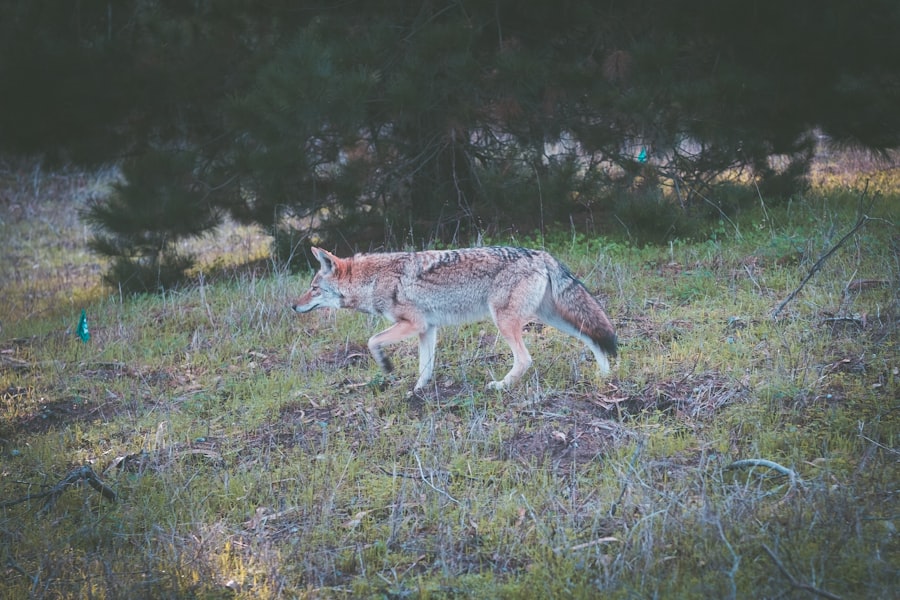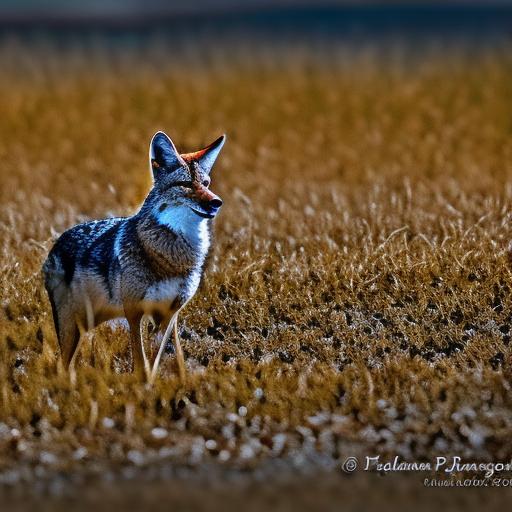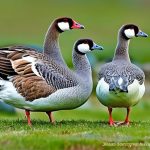Coyotes are often seen as a nuisance or a threat to humans and their pets, but they play an important role in maintaining ecological balance. One of the ways in which coyotes contribute to this balance is by acting as natural predators of geese. Geese populations have been on the rise in recent years, causing various problems for the environment and human activities. Understanding the role of coyotes in geese control is crucial for finding sustainable solutions to this issue.
Key Takeaways
- Coyotes are natural predators of geese and can help control their overpopulation.
- Coyotes deter geese through their behavior, such as marking territory and hunting.
- Coyote presence can benefit geese control and overall ecological balance.
- Coyote management strategies should prioritize coexistence and conservation.
- Coyotes can be allies in geese control and ecosystem health if human safety concerns are addressed.
The Problem of Geese Overpopulation
Geese overpopulation has become a significant problem in many areas around the world. These birds are highly adaptable and can thrive in both urban and rural environments. While they may be a beautiful sight to behold, their increasing numbers have negative impacts on the environment and human activities.
One of the main issues with geese overpopulation is the damage they cause to agricultural crops. Geese feed on grasses, grains, and other vegetation, leading to significant losses for farmers. Additionally, their droppings can contaminate water sources and contribute to the spread of diseases.
Geese also pose a threat to aviation safety. Large flocks of geese can collide with aircraft, causing damage to engines and posing a risk to passengers’ lives. This has led to increased efforts to control geese populations near airports.
Traditional methods of geese control, such as habitat modification, harassment techniques, and culling, have proven to be ineffective or unsustainable in the long term. These methods often only provide temporary relief and can disrupt ecosystems by removing natural predators from the equation.
Coyotes as a Natural Deterrent for Geese
One potential solution to geese overpopulation is utilizing coyotes as a natural deterrent. Coyotes are opportunistic predators that prey on small mammals, birds, and even waterfowl like geese. By allowing coyotes to naturally control geese populations, we can reduce the need for human intervention and potentially find a more sustainable solution to the problem.
Coyotes are highly adaptable and can thrive in a variety of environments, including urban and suburban areas. They are known for their intelligence and resourcefulness, making them effective at finding and capturing prey. By allowing coyotes to coexist with geese populations, we can tap into their natural instincts and utilize them as a natural deterrent.
How Coyotes Keep Geese Away: Understanding Their Behavior
Coyotes have several behaviors that make them effective at keeping geese away. One of these behaviors is their territorial nature. Coyotes mark their territories with scent markings and vocalizations, which can deter geese from entering those areas. Geese are wary of predators and will avoid areas where they sense the presence of coyotes.
Coyotes are also known for their hunting skills. They are agile and quick, making them effective at capturing prey. Geese are aware of this and will avoid areas where they see or hear coyotes hunting. The mere presence of coyotes can create a sense of fear and unease among geese, causing them to seek safer locations.
In addition to their hunting skills, coyotes are also known for their adaptability. They can adjust their hunting strategies based on the availability of prey. This means that if geese populations become too high in a particular area, coyotes can shift their focus to hunting geese more frequently.
The Benefits of Coyote Presence for Geese Control
Having coyotes present in areas with geese overpopulation can have several benefits. Firstly, it reduces the need for human intervention and the use of potentially harmful methods such as culling or habitat modification. Allowing coyotes to naturally control geese populations is a more sustainable approach that respects the natural balance of ecosystems.
Secondly, coyotes help maintain a healthy ecosystem by controlling geese populations. Geese can have a negative impact on vegetation and water sources, but with coyotes present, their numbers are kept in check. This allows for a more balanced ecosystem where all species can thrive without causing excessive damage.
Lastly, coyotes contribute to the diversity of ecosystems. They are an important part of the food chain and help regulate populations of various species. By recognizing the value of coyotes in geese control, we can promote a more holistic approach to wildlife management that considers the interconnectedness of all species.
Coyote Management Strategies for Geese Control

While coyotes can be beneficial in controlling geese populations, it is important to manage their presence responsibly. Here are some tips and strategies for managing coyotes in areas with geese overpopulation:
1. Educate the public: Provide information about the role of coyotes in geese control and the importance of coexistence. This can help dispel misconceptions and reduce conflicts between humans and coyotes.
2. Implement non-lethal deterrents: Use methods such as scare devices, fencing, or habitat modification to discourage geese from nesting or feeding in certain areas. This can help reduce conflicts between geese and humans without harming coyotes.
3. Encourage natural habitats: Create or preserve natural habitats that support a diverse range of wildlife, including coyotes and geese. This can help maintain a healthy ecosystem where natural predators can thrive.
4. Monitor coyote populations: Keep track of coyote populations and their interactions with geese. This information can help inform management decisions and ensure that coyote populations remain stable.
The Role of Coyotes in Ecological Balance
Coyotes play a crucial role in maintaining ecological balance. As top predators, they help regulate populations of prey species, including geese. By controlling geese populations, coyotes prevent overgrazing and damage to vegetation, which in turn benefits other species that rely on those resources.
Coyotes also contribute to the health and diversity of ecosystems by controlling populations of small mammals and birds. This helps prevent the spread of diseases and maintains a balanced food chain. Without coyotes, populations of prey species could become too high, leading to negative impacts on the environment and other species.
Recognizing the importance of coyotes in ecological balance is crucial for promoting responsible wildlife management practices. By understanding their role and implementing strategies that support their presence, we can create a more sustainable and harmonious relationship between humans and wildlife.
Coyotes and Human Safety: Mitigating Risks and Concerns
There are often concerns and misconceptions about coyotes and their potential risks to human safety. While it is important to be cautious around wildlife, it is also essential to understand that coyotes generally pose little threat to humans when managed responsibly.
Coyote attacks on humans are extremely rare. They are naturally wary of humans and will typically avoid contact if given the opportunity. However, it is important to take precautions to minimize potential conflicts:
1. Do not feed coyotes: Feeding coyotes can habituate them to human presence and increase the likelihood of conflicts. Keep all food sources secure and do not intentionally or unintentionally provide food for coyotes.
2. Secure garbage and pet food: Coyotes are opportunistic feeders and may be attracted to easily accessible food sources such as garbage or pet food left outside. Secure these food sources to minimize interactions with coyotes.
3. Keep pets leashed: When walking pets in areas where coyotes are present, keep them on a leash to prevent them from approaching or being approached by coyotes. Small pets may be seen as potential prey by coyotes.
4. Make noise: If you encounter a coyote while walking or hiking, make loud noises or wave your arms to scare it away. Coyotes are generally wary of humans and will retreat if they feel threatened.
By following these guidelines and being aware of coyote behavior, it is possible to coexist with coyotes in urban and suburban areas while minimizing potential risks.
The Importance of Coyote Conservation and Coexistence
Conserving coyote populations and promoting coexistence with humans is crucial for maintaining healthy ecosystems and preserving biodiversity. Coyotes are an integral part of the natural world and play a vital role in maintaining ecological balance.
When managed responsibly, coyotes can benefit humans by controlling geese populations, reducing the need for human intervention, and contributing to the health of ecosystems. By recognizing their value and implementing strategies that support their presence, we can create a more sustainable and harmonious relationship between humans and wildlife.
It is also important to educate the public about the importance of coyote conservation and coexistence. By dispelling misconceptions and promoting understanding, we can foster a greater appreciation for these animals and their role in maintaining ecological balance.
Coyotes as Allies in Geese Control and Ecosystem Health
Coyotes are natural predators of geese and play an important role in controlling geese populations. Geese overpopulation can have negative impacts on the environment and human activities, but traditional methods of geese control may not be effective or sustainable in the long term.
By recognizing the value of coyotes in geese control and implementing responsible management strategies, we can find more sustainable solutions to this issue. Coyotes help maintain a healthy ecosystem by controlling geese populations, contributing to the diversity of ecosystems, and promoting ecological balance.
It is important to conserve coyote populations and promote coexistence with humans. By understanding their behavior, mitigating risks, and educating the public, we can create a more harmonious relationship between humans and wildlife. Coyotes are not just a nuisance or a threat; they are natural allies in geese control and ecosystem health.
If you’re looking for ways to protect your geese from coyotes, you may also be interested in learning how to insulate a chicken coop. Proper insulation not only helps keep your chickens warm during colder months but also provides an added layer of security against predators. Check out this informative article on Poultry Wizard’s website: How to Insulate a Chicken Coop. Additionally, if you’re considering building a coop for your chickens, it’s important to know the right size it should be. Find out more about the ideal coop size in this helpful guide: How Big Does a Coop Need to Be for a Chicken? And if you’re also raising turkeys, you might want to explore whether they need a coop or not. Discover the answer in this article: Do Turkeys Need a Coop?
Meet Walter, the feathered-friend fanatic of Florida! Nestled in the sunshine state, Walter struts through life with his feathered companions, clucking his way to happiness. With a coop that’s fancier than a five-star hotel, he’s the Don Juan of the chicken world. When he’s not teaching his hens to do the cha-cha, you’ll find him in a heated debate with his prized rooster, Sir Clucks-a-Lot. Walter’s poultry passion is no yolk; he’s the sunny-side-up guy you never knew you needed in your flock of friends!







